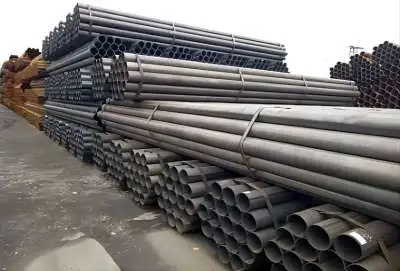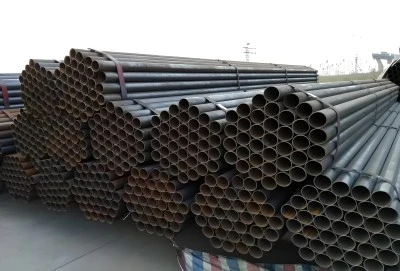In the world of steel piping, two terms often come up: EFW (Electric Fusion Welded) and ERW (electric resistance welded) pipes. While they may sound similar, these two types of pipes have distinct differences in their manufacturing processes, characteristics, and applications. This article will delve into the key differences between ERW and EFW pipes, focusing on their welding processes, material thickness and type, and strength and durability. By the end, you'll have a clear understanding of these two pipe types and be better equipped to choose the right one for your specific needs.
|
|
|
Welding Process: ERW vs. EFW
The primary difference between ERW and EFW pipes lies in their welding processes. Understanding these processes is crucial for appreciating the unique properties and applications of each pipe type.
ERW (Electric Resistance Welded) Pipe:
ERW pipes, also known as electric resistance welded pipes, are manufactured using a high-frequency electric current to heat the edges of a steel strip or skelp. The heated edges are then pressed together to form a strong, continuous weld seam. This process is highly efficient and can produce pipes at high speeds, making ERW pipes cost-effective for many applications.
The ERW process typically involves the following steps:
- A flat steel strip is fed into a series of rollers that gradually form it into a cylindrical shape.
- The edges of the strip are brought close together as it passes through the welding station.
- A high-frequency electric current is applied to the edges, heating them to welding temperature.
- Pressure is applied to force the heated edges together, creating a forge weld.
- The welded seam is then cooled and undergoes further processing, such as heat treatment or sizing.
ERW pipes are known for their uniform wall thickness, good dimensional accuracy, and smooth surface finish. They are widely used in various industries, including oil and gas, construction, and water transportation.
EFW (Electric Fusion Welded) Pipe:
EFW pipes, on the other hand, are manufactured using a different welding technique. The electric fusion welding process involves melting the edges of the steel plate or strip and fusing them together without the application of pressure. This method is typically used for producing larger diameter pipes with thicker walls.
The EFW process generally includes these steps:
- Steel plates or strips are formed into a cylindrical shape.
- The edges of the plate are prepared for welding, often with a beveled edge.
- An electric arc is used to melt the edges of the steel.
- The molten edges are allowed to flow together and solidify, forming a weld seam.
- The weld is often reinforced with additional passes to ensure strength and integrity.
EFW pipes are known for their ability to handle higher pressures and temperatures, making them suitable for more demanding applications in industries such as petrochemicals and offshore oil and gas.
Material Thickness and Type
The material thickness and type used in ERW and EFW pipes also contribute to their differences and suitability for various applications.
ERW Pipes:
Electric resistance welded pipes are typically manufactured from thinner gauge steel, usually ranging from 2mm to 12.7mm in thickness. This limitation is due to the nature of the electric resistance welding process, which is most effective with thinner materials. ERW pipes are commonly made from carbon steel or low-alloy steel, although stainless steel ERW pipes are also available for specialized applications.
The thinner walls of ERW pipes make them lighter and more cost-effective for many applications. They are ideal for:
- Water and sewage transportation
- Natural gas distribution
- Structural applications in construction
- Fencing and scaffolding
EFW Pipes:
EFW pipes can be manufactured from much thicker materials, with wall thicknesses ranging from 6mm to 50mm or more. This capability allows EFW pipes to be used in applications requiring higher pressure ratings and greater structural strength. EFW pipes can be made from a wider range of steel grades, including high-strength low-alloy (HSLA) steels and various alloy steels.
The thicker walls and diverse material options make EFW pipes suitable for:
- High-pressure oil and gas transmission
- Offshore pipelines
- Chemical and petrochemical processing
- Power plant piping systems
Strength and Durability
The strength and durability of ERW and EFW pipes are influenced by their manufacturing processes and material properties.
ERW Pipes:
Electric resistance welded pipes offer good strength and durability for their intended applications. The electric resistance welding process creates a narrow, high-quality weld seam that is often as strong as the base metal. Some key points about ERW pipe strength include:
- Uniform wall thickness contributes to consistent strength along the pipe length.
- The narrow heat-affected zone (HAZ) minimizes potential weak points.
- Post-weld heat treatment can further enhance the pipe's mechanical properties.
- ERW pipes typically have good resistance to internal and external pressures within their design limits.
However, ERW pipes may not be suitable for extremely high-pressure applications or environments with severe temperature fluctuations due to their thinner walls and limitations in material grade options.
EFW Pipes:
EFW pipes generally offer superior strength and durability compared to ERW pipes, particularly in demanding applications. The electric fusion welding process, combined with thicker materials and multiple weld passes, contributes to their robust nature. Some advantages of EFW pipes in terms of strength and durability include:
- Higher pressure ratings due to thicker walls and stronger weld seams.
- Better resistance to external forces and environmental stresses.
- Improved performance in extreme temperature conditions.
- Greater flexibility in material selection, allowing for pipes tailored to specific strength requirements.
EFW pipes are often chosen for critical applications where failure could have severe consequences, such as deep-sea pipelines or high-pressure chemical processing facilities.
Longma Group
Understanding the differences between ERW and EFW pipes is crucial for making informed decisions in various industrial applications. While ERW pipes offer cost-effective solutions for many standard piping needs, EFW pipes provide the strength and durability required for more demanding environments. The choice between these two types of pipes depends on factors such as operating pressures, temperature conditions, and specific industry requirements.
Longma Group Electric Resistance Welded Steel Pipe is manufactured to meet a range of industry standards, ensuring quality and reliability. Adhering to specifications from API 5L, ASTM A53, ASTM A500, ASTM A252, and ASTM A795, these pipes are designed for various applications in the oil, gas, and construction industries, providing a robust solution for both structural and pressure piping needs. If you are choosing your electric resistance welded pipe manufacturers, welcome to contact LONGMA GROUP at info@longma-group.com.














